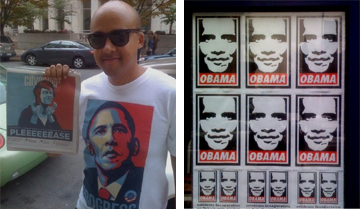[youtube:https://www.youtube.com/watch?v=q_EOzZ9iaJQ]
The German-Jewish philosopher Walter Benjamin concludes his 1935 essay on “The Work of Art in the Age of Mechanical Reproduction” with a dialectical challenge. He called on would-be art revolutionaries to respond to the way fascism was aestheticizing politics (think Triumph of the Will) by politicizing art. I’m not sure a box of “presidential peppermints” (center of image below) with the now-iconic portrait of Barack Obama was what Benjamin had in mind when he issued this call for art politics. Then again, I’m not sure the artist Shepard Fairey had mint tins in mind either (made in China, natch), when he set the ball rolling on what would become the iconic artist’s image of 2008.

The kind of aestheticized politics Benjamin worried about are now everywhere, despite the consigning of fascism to history’s dustbin. Politicians employ image consultants and stake their campaigns on television ad buys. A new candidate, even a new war, will be rolled out like a new product, complete with marketing campaign designed to stoke interest, desire, and the fantasy that unmet needs will somehow now be fulfilled. The scale and cost of even a state-wide run for office nowadays, let alone a national one, situates electoral politics firmly within a broader mediascape that citizens can see but rarely touch, be affected by but rarely affect.
As a political artist, Fairey sets out to be the exception to the rule. His art seeks to throw a wrench into the intertwined workings of money, spectacle, and power. On those terms alone, his viral campaign image succeeded spectacularly. In various permutations, it was wheat-pasted to buildings, stuck on laptops and fridges, worn on t-shirts and, once the election was over, ended up on both the year-end cover of Time magazine and in the National Portrait Gallery. With this feat, Fairey has proven himself “the foremost biological engineer in the world of virally spread guerrilla art.”
The confetti has now been swept away from a historic inauguration, a day that ends the transition from campaigning to governing. It provides a moment to reflect upon where exactly the border lies between a politicized art, art used in the service of democratic mobilization, and an art of officialdom, art that merely commemorates and enshrines the powerful in their power.
The formal aspects of Fairey’s image certainly trigger such debates. The right fixated on the resemblance of Fairey’s aesthetic to something they variously denounced as socialist realism, Soviet realism, or sometimes simply, “propaganda.” Their art history was less than exact, and they missed a larger point. Such official styles, enforced by authoritarian regimes to “reify” the revolution in a static image of state power, is not at all the same thing as a popular image, distributed cheaply or for free, in the midst of a political campaign that felt at times like a social movement.
Of course, Fairey’s style seems designed to provoke paranoid suspicions of its “subliminal message.” But his leftist, revolutionary, and propagandistic references are perfectly overt, making decoding pointless. If anything, Fairey presents the opposite problem to the left: in so successfully appropriating an international iconography of revolution and subversion, he opens himself to the accusation that his work is simply radical chic.
The most vociferous criticism of Fairey is that he has sold out street art for personal wealth and fame, and thus corporatized subculture and cultural resistance. Again, this point seems a little too obvious: Fairey-designed “E Pluribus Venom” replica money hyping his recent gallery show was “spotted in crumpled piles on the streets (literally) of NYC and LA.” Lucky spotters were either thrilled to score a valuable Shepard Fairey artwork or, presumably, bummed that the wad of much-needed cash turned out to be some sort of Monopoly version. The replica money shows how the art world and the street can be two sides of the same note. In doing so, Fairey’s approach seems to take a more dialectical approach to art, commodification, and politics than the purist stance of the outsider ever could.
A prime concern for Walter Benjamin, as for Fairey, was not simply what art looks like, but its mode of production. To participate in a radical aesthetics is not simply to portray revolutionary icons or propagandize for particular causes, but to change how art is made, how it is distributed, and who can make it. It was in this artistic mode of production that Fairey proved ingenious, using a limited edition print sale to fund a poster campaign that then spread in recombinant fashion, with versions, knockoffs, and satires all disseminating both within and beyond the official campaign structure and into popular culture.

By the time an image of a young white woman fervently crossing both fingers appeared on the cover of Philadelphia’s City Paper the week before the election (above left), the recognizability of Fairey’s portrait had extended to its very schema. Two shades of blue and one of red were enough to signal “Obama supporter.” And if this version underscored how effectively Fairey had “branded” Obama, another turned the joke around (above right), and humorously suggested that Obama had now supplanted Andre the Giant as the official Fairey “brand.”
With these sorts of detournings of Fairey’s quasi-official portrait already proliferating past election and inauguration season, perhaps his success, far from selling out street culture to the highest bidder, or bending a knee to charismatic political patronage, will inspire more subversions—and subversions of subversions—that will continue to energize a popular, political aesthetics. If he can do it, why not you?
Tavia Nyong’o teaches black art, culture and history in the Department of Performance Studies at New York University. His first book, The Amalgamation Waltz, is out from the University of Minnesota Press, and he blogs at Kenyanthropus.




Pingback: A Fairey Tale | Art21 Blog « รวบรวมรูปตลกๆ รูปน่ารัก
Pingback: Tall Dark and Shadowy 1/23/09 « To Fear It Is To Know It
Pingback: Pop propaganda « Kenyanthropus